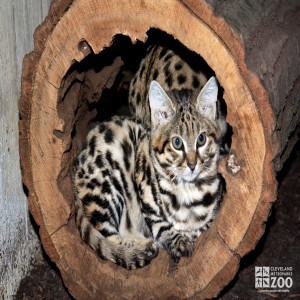Black-Footed Cat
[Felis nigripes]

The Black Footed Cat has a head and body length of about 18 inches (0.5 meters) and a tail length about 7 inches (0.18 meters). Black footed cats weigh about 3.5 pounds. The legs are relatively long, and the head is wide with large, rounded ears. Its coloration ranges from cinnamon-buff in the south to tawny in northern populations and are heavily spotted and barred. There are 3 broad transverse bars on the upper limbs and narrow, shorter bars on lower limbs. The undersides of the feet are black (hence the name). Four black bands from the head or nape extend onto the back and flanks, and the tail is spotted with a black tip. The underparts are pale with a white chin, chest and insides of thighs. The black-footed cat is nocturnal and usually solitary. It is the smallest cat species in Africa and is a good climber.
Location: Primate & Cat
Share:
Range
The range of the black footed cat is the southwest arid zone in Botswana, Namibia and the Karroo south of the Orange River.
Habitat
The black footed cat inhabits open country with cover in the form of scrub, bushes and clumps of grass. This includes open savanna, grasslands, and semi-desert areas.
Conservation Status
VulnerablePrimary Threats
Human Wildlife Coexistence, Climate ChangeGestation
Gestation in black footed cats is 63 to 68 days.
Litter
Black footed cats may have litters of 1 to 3 kittens. On average 2 per year.
Behavior
By day the black-footed cat lies up in disused burrows or in termite-mound ventilation shafts. They have a secretive behavior and will not use trails or tracks of other animals. The arid country it inhabits is mostly waterless, but it will drink occasionally when rainwater pools are present. It is solitary and territorial. It is nocturnal and so shy that it hides at the slightest disturbance. It has the reputation of being more intractable and antisocial in captivity than any other cat. Even kittens taken before their eyes open and hand-reared make defensive threats and retreat to dark corners or attempt to attack their owners. Skill and persistence in digging suggest that they dig for insects, spiders and other subterranean prey.
Reproduction
The males mature at 9 months of age and the females at 7 months. Estrus in the black footed cat lasts only about 36 hours. A female will accept copulation for a period of only 5 to 10 hours, during which time a pair mates up to six times. Kittens quickly mature at birth and develop quickly. Their eyes open at 6 to 8 days and they leave the nest at 4 weeks. They start eating solid food at 5 weeks and capture prey (mice) at 6 weeks. A captive mother kept her kittens from leaving the nest until they were 3 weeks old but later actually hauled kittens reluctant to leave out by the nape. She tried to move the nest site every 6 to 10 days.
Wild Diet
Small rodents, insects, ground birds and lizards
Zoo Diet
Vegetables, fruits, a nutritionally fortified pellets and fish as available
